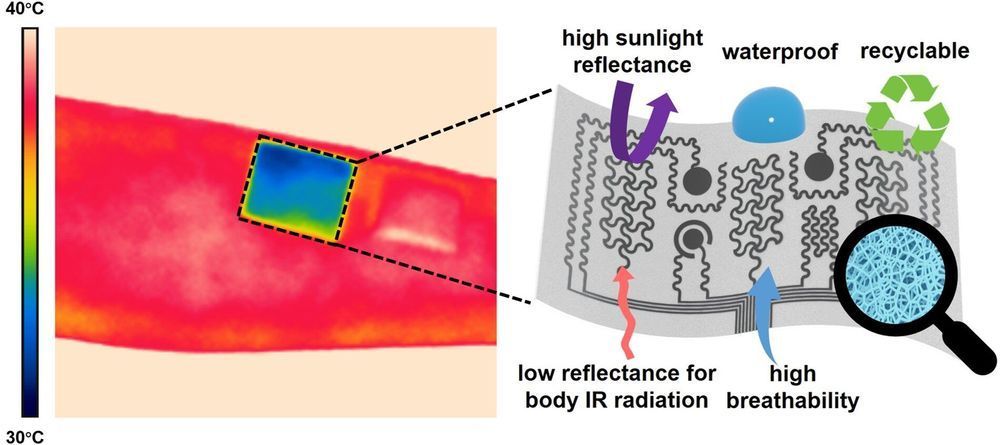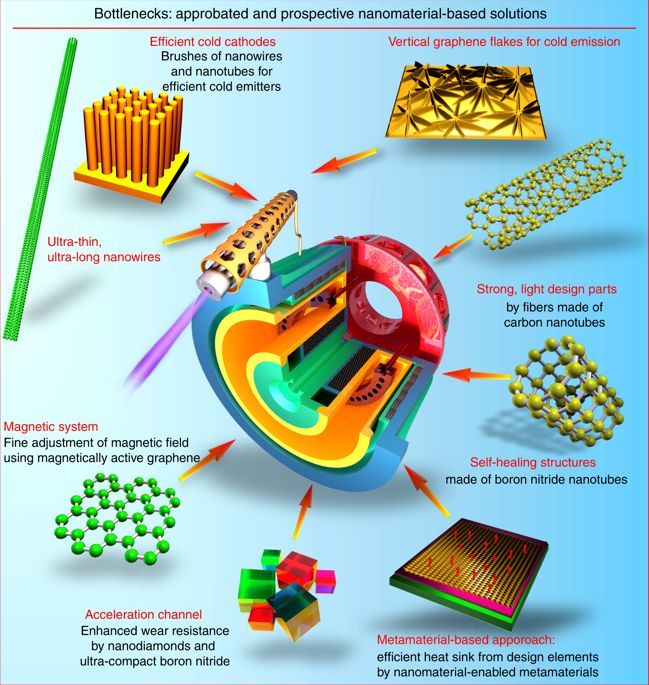Billions of dollars are being invested into research on aging, with promising early results. What if immortality were possible?




One day, soldiers could cool down on the military battlefield—preventing heat stroke or exhaustion—by using “wearable air conditioning,” an on-skin device designed by engineers at the University of Missouri. The device includes numerous human health care applications such as the ability to monitor blood pressure, electrical activity of the heart and the level of skin hydration.
The findings are detailed in the journal Proceedings of the National Academy of Sciences.
Unlike similar products in use today or other related concepts, this breathable and waterproof device can deliver personal air conditioning to a human body through a process called passive cooling. Passive cooling does not utilize electricity, such as a fan or pump, which researchers believe allows for minimal discomfort to the user.

Drastic miniaturization of electronics and ingression of next-generation nanomaterials into space technology have provoked a renaissance in interplanetary flights and near-Earth space exploration using small unmanned satellites and systems. As the next stage, the NASA’s 2015 Nanotechnology Roadmap initiative called for new design paradigms that integrate nanotechnology and conceptually new materials to build advanced, deep-space-capable, adaptive spacecraft. This review examines the cutting edge and discusses the opportunities for integration of nanomaterials into the most advanced types of electric propulsion devices that take advantage of their unique features and boost their efficiency and service life. Finally, we propose a concept of an adaptive thruster.

Doctors have used focused ultrasound to destroy tumors without invasive surgery for some time. However, the therapeutic ultrasound used in clinics today indiscriminately damages cancer and healthy cells alike.
Most forms of ultrasound-based therapies either use high-intensity beams to heat and destroy cells or special contrast agents that are injected prior to ultrasound, which can shatter nearby cells. Heat can harm healthy cells as well as cancer cells, and contrast agents only work for a minority of tumors.
Researchers at the California Institute of Technology and City of Hope Beckman Research Institute have developed a low-intensity ultrasound approach that exploits the unique physical and structural properties of tumor cells to target them and provide a more selective, safer option. By scaling down the intensity and carefully tuning the frequency to match the target cells, the group was able to break apart several types of cancer cells without harming healthy blood cells.

Robin looks like an ordinary twelve year old girl. She is about to run a mile for gym class and expects to do well. She comes in dead last, gasping for air by the end. Fast forward one year: her hair is graying, her skin bruises easily, and she suffers from chronic fatigue. Robin, now in her thirties, is completely gray.
Robin has a rare condition that prematurely shortens telomeres. Her father had the same condition. Before passing away at forty three, both of his hips had been replaced due to bone and muscle loss. What’s happening to Robin is happening to all of us, just at a slower pace.
In 1961 Leonard Hayflick found fetal cells would divide a finite number of times. This overturned the long-held (and now ridiculous sounding) belief that all cells are immortal. The maximum number of divisions allotted to them could not be altered by his best efforts.
Recent AI lecture by Stanford University.
What do web search, speech recognition, face recognition, machine translation, autonomous driving, and automatic scheduling have in common? These are all complex real-world problems, and the goal of artificial intelligence (AI) is to tackle these with rigorous mathematical tools.
In this course, you will learn the foundational principles that drive these applications and practice implementing some of these systems. Specific topics include machine learning, search, game playing, Markov decision processes, constraint satisfaction, graphical models, and logic. The main goal of the course is to equip you with the tools to tackle new AI problems you might encounter in life.
Instructors:
Tesla vehicles are apparently going to talk to people not only inside the car but also outside. CEO Elon Musk even released a quick preview video.
It’s no secret that Tesla wants to use more artificial intelligence in its business.
Two years ago, Tesla hired Andrej Karpathy to lead its computer vision and AI team and they have been expanding their team since then.

(NaturalNews) Turn over a brick or a board that has been lying in the yard for a while and underneath you may find a collection of pill bugs scurrying about. Also known as “rollie pollies” or woodlice, these grey-colored creatures can be found in many dark, moist environments feeding on decaying matter. What’s interesting about these critters is that they are not bugs at all. They are crustaceans and more closely resemble crabs and shrimp, not insects. They are characterized by their ability to roll up into a ball when they feel threatened. Another unique feature is that they have seven pairs of legs. They also act like kangaroos, toting their eggs around with them in a special pouch called a marsupium, located on the pillbug’s underside. Even stranger, they don’t urinate. Instead, they exchange gases through gill-like structures.
Breeding or collecting pill bugs may be an important practice for homesteading and gardening. The guts of these pill bugs contain a number of microbes that help the critter feed on dead, organic matter. By releasing mass quantities of pill bugs into a mature garden, one can be assured that dead plant matter is being properly broken down and returned to healthy soil. Pill bugs literally speed up the process of decomposition. They circulate the soil. This can be very useful in composting. Treats for pill bugs include fungus and monocotyledonous leaves.
Pillbugs play an important role in the cycle of healthy plant life. They return organic matter to the soil so it can be digested further by fungi, protozoans and bacteria. This process produces a natural supply of nitrates, phosphates and other vital nutrients that plants need to thrive now and in future growing seasons. It is important not to introduce pill bugs into the garden too early, as they tend to munch on emerging plants. The grey soil workers often live up to three years.

“Tim Crow must be proud to see his theory being tested at a complex level.” That’s how I tweeted the news on a recent Brain article by van den Heuvel et al (2019). Tim Crow’s theory on schizophrenia as a possible by-product of human brain evolution was quite inspiring and led to many fruitful discussions in our evolutionary psychiatry group when I was a junior trainee (which I wrote about a while ago: EPSIG Newsletter, June 2018). And here it was, the theory was tested by using novel methodology. Now I am pleased to say that the article did not disappoint, so I can enjoy the initial thrill and share my take with the Mental Elf World.
Tim Crow’s original question was intriguing: “Is schizophrenia the price that Homo sapiens pay for language?” (Crow, 1997). He argued that schizophrenia may be considered an extreme variation of brain systems which are relatively new in evolutionary timescale. Brain structures that are mostly implicated in schizophrenia were also unique to humans as mediators of language and higher cognitive functions. Those relatively new (in evolutionary timescale) brain systems may be more vulnerable to insults (e.g. stress, trauma, neurodevelopmental conditions) and manifest as dysfunctional brain circuits in schizophrenia.
The prevalence of schizophrenia is fairly constant across human populations (Jablensky et al. 1992), and the prevalence does not change despite low fecundity rates of people with schizophrenia. This can only be possible in the case of overall genetic predisposition across the population.